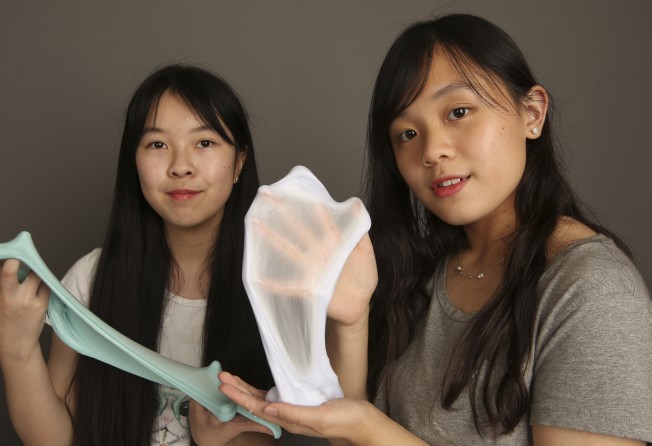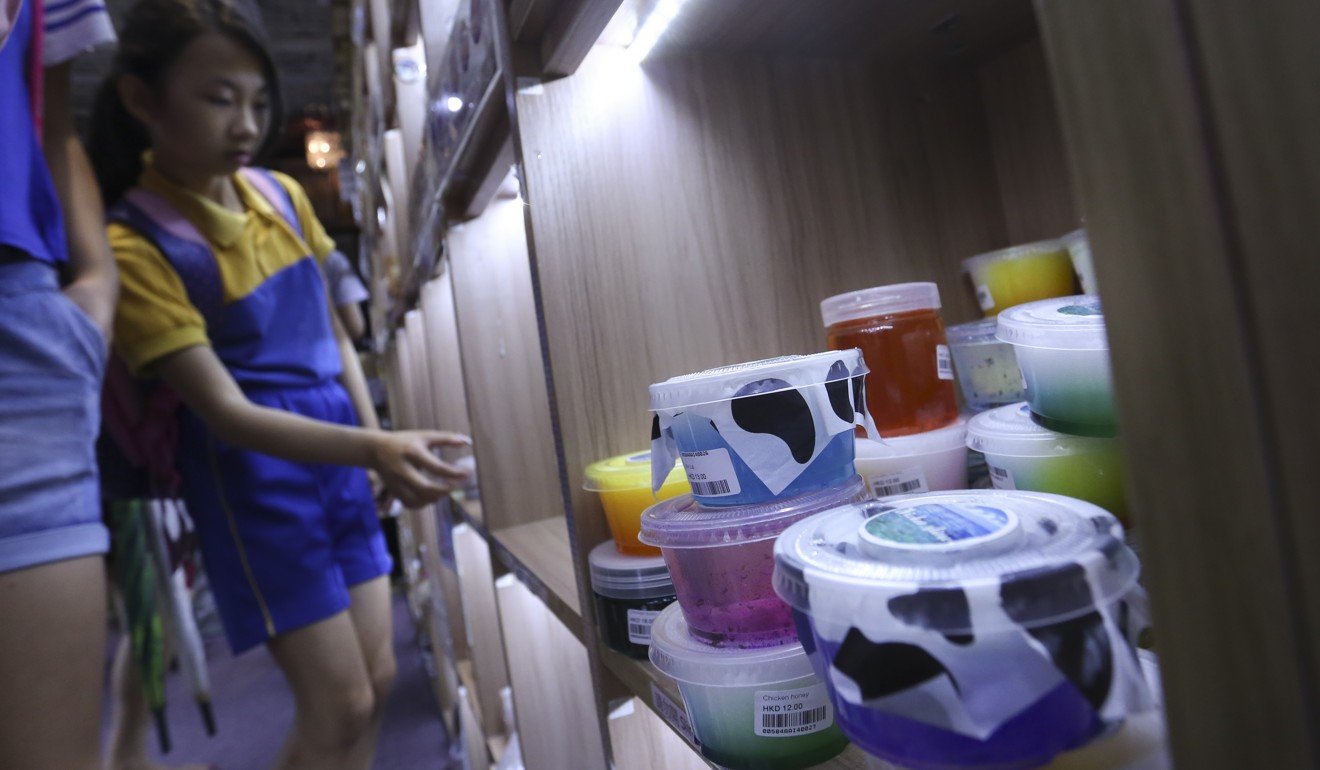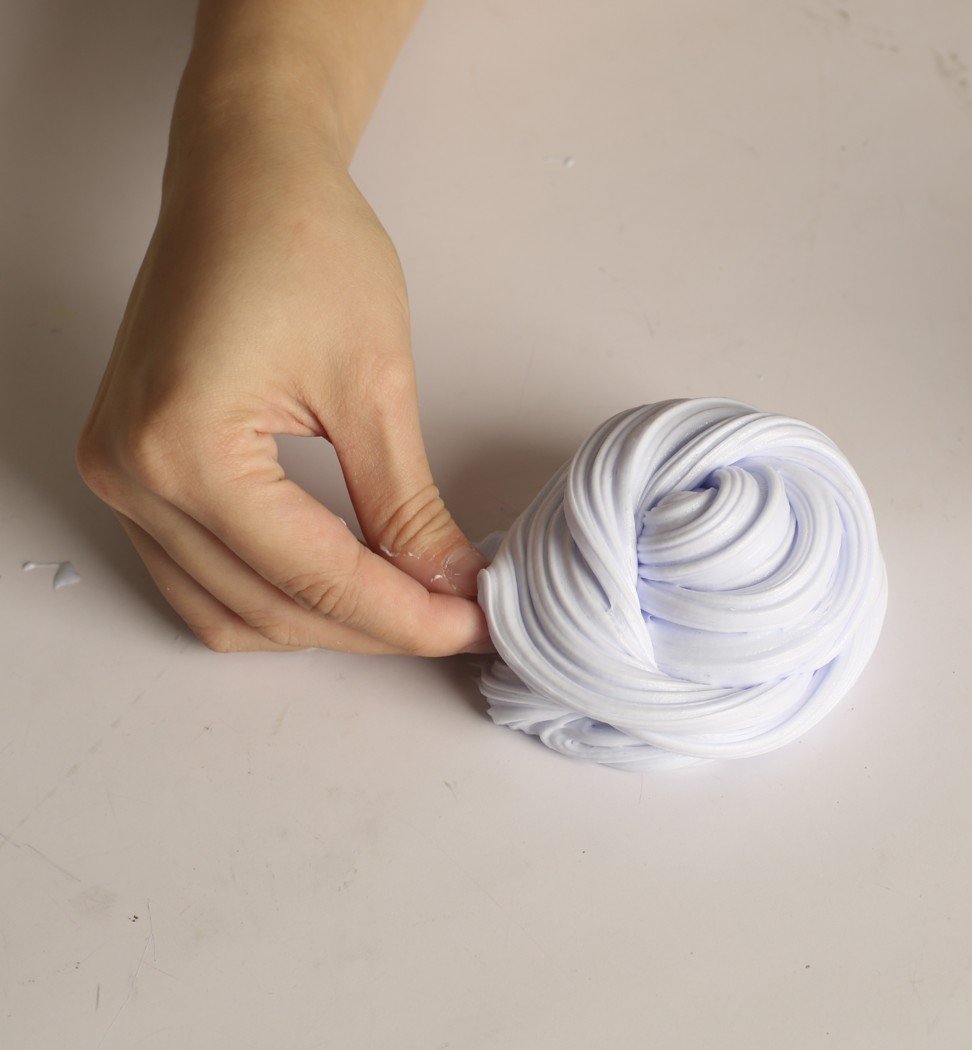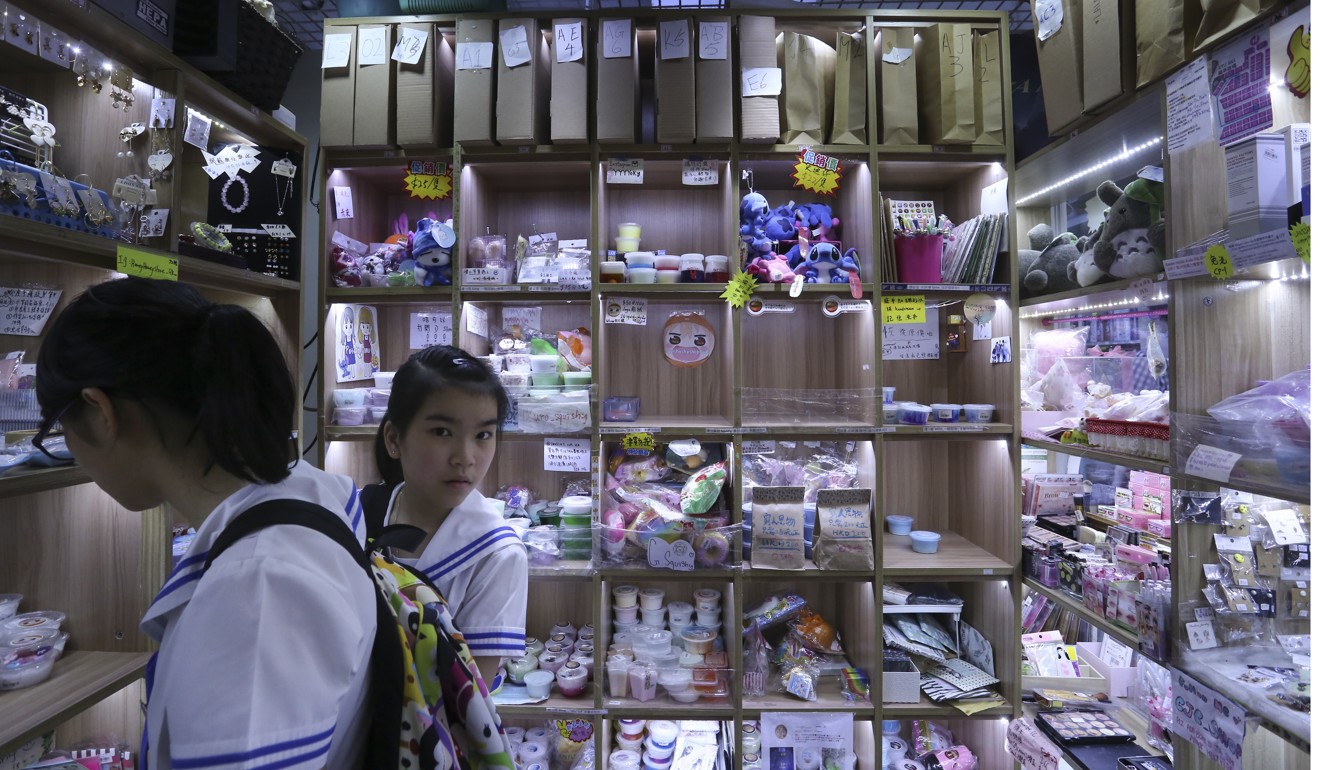Hong Kong teen entrepreneurs cash in on slime craze, but why do kids love playing with it in the first place?
Gloopy, glutinous but ultimately gleeful for many, slime has exploded in popularity worldwide over the past year, with some sharp-minded schoolkids making a bit of extra pocket money by selling jars of their own concoctions

The working-class Kowloon district of Sham Shui Po is the go-to place for Hongkongers in search of absolutely anything they’re looking for at affordable prices. Electronics, phone accessories and second-hand knick-knacks are the bread and butter of shopkeepers and hawkers on Apliu Street.
Buttons, beads and other handicraft accessories are there to choose from around the block on Yu Chau Street. But there’s another kind of product that’s now in huge demand in units at the nine-storey Dragon Centre shopping mall. This has become the place to go in Hong Kong for one of the latest crazes among youngsters – a gloopy, glutinous plaything called slime.
Young children and tweens are flocking to tiny cubicle shops on the mall’s seventh floor to buy the stuff.
“About 70 to 80 per cent of the products in our shop are slime-related,” says Bear Chan, store manager at B Bear Company, which rents display locker space to young slime sellers. “We sell slime as well as the products and materials used to make it.”

On a typical weekend, her tiny shop is crowded with groups of children, from eight- and nine-year-olds to 18-year-olds, coming and going with multiple containers of slime in tow.
“Kids today like things that they can squeeze or poke, things that they can use to get their frustrations out,” Chan says. “Since slime is cheap, it appeals to them. It can also be easily made, so they can enjoy the making process too.”
Chan explains that slime first appeared at the Dragon Centre about two to three years ago, but it’s hard to pinpoint exactly when and where the trend began to gather steam in Hong Kong. Some observers say it originated from the ASMR community, which stands for autonomous sensory meridian response, and refers to visuals and sounds that soothe and create a tingling sensation on the skin.

What is certain, though, is that interest in the gooey plaything has exploded worldwide over the past year. YouTube and Instagram host millions of videos and photos of people poking and stretching slime, as well as teaching others how to make their own.
The noise is really satisfying. It’s even satisfying to just watch people playing with slime on Instagram. I mostly like seeing the holes [formed by poking] go down
The basic ingredients are white glue, water and borax, a cleaning agent found in a number of household items that thickens the glue when combined. Makers say they buy borax in big plastic bags from pharmacies. Other materials such as shaving foam, soap, liquid starch, glitter, beads and other decorations can be added to the slime mix to give it different textures or looks.
A search of the #slime hashtag on Instagram produces more than three million posts, while the #slimehk hashtag will find over 96,000 hits.
One of the most popular local slime accounts belongs to 17-year-old Nicole Wun Cheuk-lam, aka @slime.donutb. She started her account in September 2016 and has amassed more than 44,000 followers.
“A lot of people find slime strange but I think it helps relieve stress,” Wun says. “You can poke it and play with it when you’re bored or tired from studying. It really helps.”
A post shared by DonutŚłįmę Šëłłér (@slime.donutb) on Jun 27, 2017 at 12:32am PDT
Nicole first learned about slime in June last year through YouTube videos and began to make it just for fun. “At the beginning, I just wanted to share with other people something that I made. But as more people liked it, it eventually led me to selling it to make some extra money,” she says.
She rents a display locker at the Dragon Centre and visits weekly to restock her colourful creations. Her containers of slime sell for HK$15 each and she sells between 60 and 70 containers a week. She says the most she’s made in a week is HK$1,600.
Nicole adds food colouring and other materials to her slime to make it stand out from the many others for sale in Dragon Centre. “Basically if people think your slime is pretty, they’ll buy it,” she explains.

For fellow slime maker Ellen Ho, that means experimenting with multiple layers and adding small trinkets to her slime.
“Slime from each store is more or the less the same. They have the same packaging,” says the 15-year-old, who also rents a display locker at the mall. “I don’t want my slime to be too boring so I use different-shaped containers or glass bottles I buy from Taobao to make them stand out. It gets quite boring if I restock the same things every week.”
Ellen sells 30 to 40 containers of slime a week for HK$10 to HK$14 apiece, depending on the mix and container size. On a public holiday she can sell that amount in a day.
Although Ellen and Nicole are earning money, Ellen says she doesn’t know the exact amount because she doesn’t keep track of the costs. What they enjoy most is the sense of achievement. “It’s really satisfying when people buy my slime and tell me how fun it is and how much they like it,” Nicole says. “It makes me feel really proud and happy.”
Besides cubicle stores, local slime lovers are looking for other ways to share their handmade creations. Maya Baig and Anya Ali are currently building a website, called “Slimeacorns Maya and Anya’s Company”, to sell their product. The 10-year-old girls were first intrigued by the science behind slime and enjoyed its ASMR qualities.
“When you poke slime, it can make a clicking, crackling or popping sound and that calms down some people,” Anya says.
“The noise is really satisfying,” Maya adds. “It’s even satisfying to just watch people playing with slime on Instagram. I mostly like seeing the holes [formed by poking] go down. And when you make a swirl, it’s really cool.”

Their website will advertise a variety of slime samples in both small and large sizes (at HK$15 and HK$20, respectively) from scented selections to seasonal editions. However, unlike Ellen and Nicole, they don’t use borax in their slime because they read reports of children suffering second- and third-degree burns from allergic reactions to the cleaning ingredient. Instead, they use liquid starch as a safer alternative to thicken the glue into slime.
At least it’s an activity that takes kids away from computers and phones. It’s scientific, in a sense
Besides building their own website, what will set Maya and Anya’s slime business apart is that they intend to donate half of the money they earn from their slime sales to help Syrian refugees in Lebanon. Maya says she’s greatly inspired by her grandmother, who set up an NGO and raised money to build three schools for the refugees.
“I went to the refugee camps in Lebanon last summer and it really was sad to see the amount of people that were there. It was scary as people were dying,” Maya says. “I realised that no one deserves to be like that, especially those people who had everything taken away from them. That’s why I decided to donate our earnings and Anya was completely fine with that.”
“If we simply just make slime, there’s really no purpose so we wanted to help people out,” Anya adds.

Maya’s mother, Maria Bizri, was proud when she heard of the girls’ decision because it showed they were applying their interests to give back to the world. She admits she does occasionally get a little frustrated with the mess that the slime making causes, but overall she views slime as a positive thing.
“At least it’s an activity that takes kids away from computers and phones,” she says. “It’s scientific, in a sense. They learn how materials react to each other. They’re also developing recipes, using a bit of maths with counting and measurements, and even learning some business skills. It’s using different parts of their brains. I definitely prefer it to the trend of televisions and smartphones.”
The four budding entrepreneurs are unsure how long the slime trend will continue, but until the next big thing comes along, they will continue to create and share their handmade concoctions one plastic container at a time.